The Illustrated Encyclopedia of Hindusim vol 2
You also want an ePaper? Increase the reach of your titles
YUMPU automatically turns print PDFs into web optimized ePapers that Google loves.
Parinamavada<br />
need, he will forget everything he has<br />
learned as his student.<br />
Parashurameshvar Temple<br />
Temple constructed about 750 C.E. in<br />
the city <strong>of</strong> Bhubaneshvar in the state<br />
<strong>of</strong> Orissa, dedicated to the god Shiva<br />
in his aspect as the “Lord <strong>of</strong><br />
Parashuram.” This title refers to<br />
Parashuram’s long period <strong>of</strong> asceticism,<br />
in which he worshiped Shiva as<br />
his chosen deity and was rewarded<br />
with Shiva’s grace. <strong>The</strong> temple is an<br />
early example <strong>of</strong> the Orissan variant<br />
<strong>of</strong> the northern Indian Nagara temple<br />
style. <strong>The</strong> Nagara style emphasizes<br />
verticality, with the whole temple<br />
building culminating in a single high<br />
point, and the Orissan variant <strong>of</strong> this<br />
style has a single enormous tower<br />
(deul) over the image <strong>of</strong> the temple’s<br />
primary deity, with shorter subsidiary<br />
buildings leading up to it. <strong>The</strong><br />
Parashurameshvar temple is the first<br />
example <strong>of</strong> this basic pattern—a low,<br />
flat assembly hall (jagamohan), followed<br />
by a much taller and narrower<br />
tower (deul), in this case about forty<br />
feet high. Although later Orissan temples<br />
are much larger—some <strong>of</strong> the<br />
deuls tower over 200 feet—and <strong>of</strong>ten<br />
include additional buildings and structures,<br />
they all retain this basic pattern.<br />
Parashuram Jayanti<br />
Festival marking the birthday <strong>of</strong><br />
Parashuram avatar, Vishnu’s sixth<br />
avatar. This takes place on the third<br />
day <strong>of</strong> the bright (waxing) half <strong>of</strong> the<br />
lunar month <strong>of</strong> Baisakh (April–May),<br />
the same day as the festival <strong>of</strong><br />
Akshaya Trtiya.<br />
Parikshit<br />
Mythic king in the Lunar Line, who<br />
serves as an example that one’s fate cannot<br />
be escaped. Parikshit is the grandson<br />
<strong>of</strong> Arjuna, one <strong>of</strong> the five Pandava<br />
brothers who are the protagonists in the<br />
Mahabharata, the later <strong>of</strong> the two great<br />
Hindu epics.<br />
Parikshit inherits the throne from<br />
Yudhishthira, Arjuna’s elder brother,<br />
and according to tradition rules righteously<br />
for sixty years, but it is his death<br />
that is best remembered. Fond <strong>of</strong> hunting,<br />
Parikshit one day comes across a<br />
meditating sage while he is chasing a<br />
wounded deer. When the sage refuses to<br />
answer to his inquiries about the deer,<br />
Parikshit grows angry and, with his bow,<br />
drapes a dead cobra around the sage’s<br />
neck. <strong>The</strong> sage remains unaware <strong>of</strong> this,<br />
but his son finds out about it when his<br />
playmates jeer at him. Furious, the son<br />
lays a curse that the person responsible<br />
will be fatally bitten within seven days<br />
by the great serpent Takshaka. When he<br />
discovers that the king is responsible,<br />
the son repents his curse to the King.<br />
Parikshit takes all possible precautions<br />
to avoid his fate. He builds a house<br />
on a huge pillar, has anything brought<br />
into the house carefully searched, and<br />
surrounds himself with physicians who<br />
can cure snakebite. After six days without<br />
incident, the king begins to relax his<br />
vigilance. As the seventh day is ending,<br />
Takshaka conceals himself as a worm in<br />
a piece <strong>of</strong> fruit, changes into his real<br />
shape when the fruit is cut open, and<br />
bites the king, killing him.<br />
Parinamavada<br />
(“transformation-relationship”) Philosophical<br />
perspective that explains the<br />
relationship between the Ultimate<br />
Reality or realities and the perceivable<br />
world, and describes the world as a genuine<br />
transformation <strong>of</strong> this reality.<br />
This position is espoused by proponents<br />
<strong>of</strong> the Samkhya, Vishishthadvaita<br />
Vedanta, and Bhedabhada philosophical<br />
schools. All three <strong>of</strong> these are<br />
proponents <strong>of</strong> a causal model called<br />
satkaryavada. <strong>The</strong> satkaryavada model<br />
assumes that effects preexist in their<br />
causes, and that, when these effects<br />
appear, they are transformations (parinama)<br />
<strong>of</strong> those causes. <strong>The</strong> classic<br />
example for this model is the transformation<br />
<strong>of</strong> milk to curds, butter, and clarified<br />
butter: each <strong>of</strong> these effects was<br />
501

















